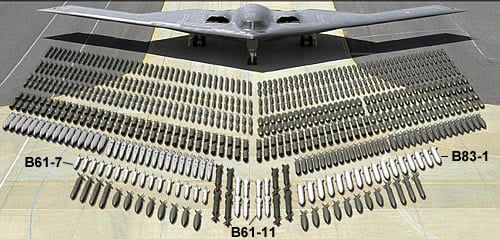Why Bombers Are Key to Nuke Modernization; Think Russia, North Korea, China
Posted on
Opponents of nuclear modernization worry that the presidential elections this year could end their hopes of killing a number of nuclear modernization programs—such as the Long Range Stand-Off cruise missile (LRSO) and the B-61 Mod 12 life extension program. Unfortunately for nuclear minimalists and abolitionists, President Obama has been true to his word and continued to support nuclear modernization, which he agreed to in order to win Republican support for ratification of the New Start Treaty (2010). Russia, China, and North Korea’s aggressive actions have helped insure Obama continues to support nuclear modernization.
These programs are not a waste of taxpayer dollars as some suggest. Instead, they are a central tool in the daily use of nuclear weapons to maintain a credible strategic deterrent. With the bomber force set to employ both the LRSO and the B-61 Mod 12, it offers perhaps the best example of why nuclear modernization offers tangible benefits to the nation.
The North Korean Example
Twice over the past three years, the United States has responded to North Korea’s escalatory actions with long-range show-of-presence missions flown by Air Force’s B-2s and B-52s. In December 2012, North Korea tested a long-range rocket, which was followed with a nuclear test on February 12, 2013.
Then, as South Korea and the United States prepared for its semi-annual joint exercise on the Korean peninsula, North Korea continued to sabre rattle by declaring the exercises were preparation for nuclear war. The North Korean government even went so far as to reiterate its stance that the 1953 armistice was invalid. As tensions escalated, the United States launched two B-2 stealth bombers from the United States on a round-robin mission across the South Korean peninsula. The B-2s flew over South Korea and dropped practice munitions on one of the South’s ranges during the exercise while being escorted by South Korean fighters. Tensions eased afterwards, but only temporarily.
Similarly, two days before Kim Jong-Un’s birthday the North Korean government claimed it tested a hydrogen bomb. Just a few days later, Pacific Command (PACOM) dispatched a B-52 to fly over South Korea in formation with South Korean fighter aircraft.
Deterrence is not a one-time action, but a daily effort that requires the right tools to prevent escalatory behavior from turning into conflict. Thus, when the Air Force sends its B-52s or B-2s to South Korea as a warning to the North, it is important that our adversaries know these aircraft possess the latest nuclear cruise missiles and highly accurate nuclear bombs.
It is this knowledge that makes assurance and deterrence missions flown in response to escalatory actions credible. It is because of American capability that Adm. Harry Harris, commander of PACOM, can credibly say: “This was a demonstration of the ironclad US commitment to our allies in South Korea, in Japan, and to the defense of the American homeland.”
The larger diplomatic message that the United States seeks to send is reliant on the nation having both the capability and the will to carry out any threats. Given that the relationship between North Korea and the United States is extremely complex, it is all the more important that North Korea know how seriously the United States takes its nuclear arsenal and its obligation to protect South Korea.
Nuclear modernization and the use of nuclear capable bombers not only signal to North Korea our capability and will, they also signal to other nations in the region who may wonder whether American words have meaning when the stakes are high.
While the nuclear mission of our bombers may sometimes invoke the macabre image of nuclear weapons destroying cities, it is this very image that aids the United States in ensuring deterrence does not fail. It is worth remembering that the bomber is the only leg of the nuclear triad that can effectively signal American intent to an adversary. Neither intercontinental nor submarine launched ballistic missiles can do so. And when paired with a modernization program for the very weapons that will inflict great pain, the United States is more credible when sending the desired signal.
Although some opponents of nuclear modernization and the bomber leg of the nuclear triad suggest that a nuclear capable bomber and new or modernized weapons are unnecessary, the simple fact remains—no other leg of the triad can daily serve as a visible signal of American resolve. Given that the North Koreans are fond of testing such resolve; can we really afford not to maintain a capable bomber force with the most advanced nuclear weapons?
Maj. Chris Winklepleck serves in the 608 Air Operations Center at Barksdale Air Force Base. Adam Lowther is Director of the School of Advanced Nuclear Deterrence Studies. The views expressed in this article are those of the authors and do not necessarily reflect the official policy or position of the Air Force, the Defense Department or the U.S. Government.
Subscribe to our newsletter
Promotions, new products and sales. Directly to your inbox.

